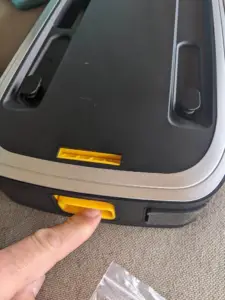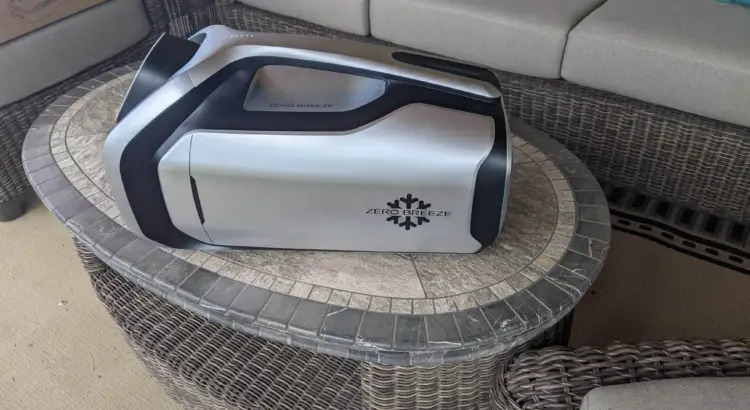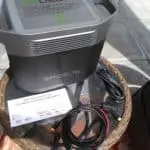I was in need of a portable A/C (air conditioning) unit, the reason for which I will explain shortly, and was able to acquire one directly from Zero Breeze. Because it’s a growing market, I wanted to write a review for their Mark 2 model from the perspective of an RVer — to sort out what portable air conditioners can and can’t do, and let you know how the Zero Breeze stacks up.
What is the Mark 2?
The Mark 2 is a very small, very real air conditioning unit that can run off shore power or its own lithium battery. I say “very real” because there are a number of small units out there that imply they are air conditioners, but are actually swamp coolers (evaporative coolers) or require you to add ice. This is none of those things. It is just as much an A/C unit as the ones found in cars, with compressors, etc.
What makes the Zero Breeze different from most true air conditioners is that the unit is quite compact, can be carried around by a handle, and isn’t terribly heavy.

Why would an RVer want a portable A/C unit?
This is where I explain why I wanted an A/C unit. But I’ll also share a few other areas that portable A/C units shine.
- When the size of your RV requires just a little more than a single A/C unit, so you need to spot cool somewhere better, like your sleeping area, or where your pets are.
- When you only want to cool one area and you don’t enjoy the constant loud noise of larger A/C units.
- When you only have a 30amp shore power connection that would trip the breaker if you tried running both of your two main A/Cs.
- If you are venturing out from your RV and are tent camping or using something like a Clam shelter, or even sitting outside, but still want the comfort of cooling. It would also be great for boats, or when you stop in a vehicle and don’t want to keep the engine running to run the A/C.
- If you are a van RVer and you want to cool your rig without having to run the engine which is inefficient and frankly expensive with current fuel prices.
- If you are a boondocker, and you need a low-power A/C unit to stay cool that can either run off its own charged battery, solar, your inverter, or a smaller, quieter generator.
The first reason is why I wanted one, the last reason is why it’ll get used a lot by me.
Pros and Cons
It’ll take a little while to speak to durability but the pros and cons are pretty easy to assess right away. I’ll update this article as to the longer range conclusions as they become apparent.
Pros
- You got it to cool right? So what can it do? It can lower the temperature by 30°F in 10 minutes when chilling at its highest setting. Pretty impressive for a battery powered air conditioner.
- You can cool just the area you are in pretty precisely. Whether is a small area (like a sleeping area), or just blowing on you, you aren’t also trying to cool the RV basement or rooftop like many of the full-RV AC units do if they are ducted.
- It can run off battery! Somewhere between 3 to 5 hours depending on the cooling setting. This means you can charge up the battery using solar panels or an inverter. However, it does only come with one charger, so you can only either run the unit off an AC, or charge the battery. Otherwise, you will need to purchase an additional charger.
- The manual is well written. None of the strange manual language you find in lots of manuals. Although it is a bit brief of some of the more extended charging information.
- Includes a hose to direct the cooler output air. This is nice to focus the cooling directly into a space or onto you. There are two hoses that require venting the removed hot air to outside like all good A/C units. So either those hoses have to reach a window or opening, or you place the unit outside and use the cooling hose to vent the cool air into your inside space.
- It uses a rotary compressor (like most cars), which makes it efficient but also reasonably quiet. I mean it still has the compressor, fan, and rushing air noise, but it’s nothing like the big noisy overhead RV air conditioners. I find it a nice break from the endless drone of those to a much more reasonable level that can you can easily hold a conversation near. Sleeping mode is even quieter.
- It has a two-hose exhaust and intake system. Two-hose portable A/C units are significantly more efficient in cooling because you aren’t recycling the same hot air to try and cool it.

In spite of high portability, when used inside, there are various hose considerations, such as the rear exhaust and intake hoses, and the captured moisture hose. You will need to take this into account when finding a spot for it inside. You are also provided with a hose for the cold air output, if you’d rather place the unit outside and direct the cold air inside instead, or just to precisely direct where the cold air blows.
Cons
- It is expensive. Although only a fraction of what a large AC costs. Some of the cost is wrapped up in that it includes a solid lithium battery. Prices change frequently, so check here for current pricing. Also, use the code COOLRVSTUFF80 on the Zero Breeze website to get $80 dollars off until October 31, 2023.
- It won’t cool a large space. A maximum of something around 115 square feet. But the smaller the space, the better. At this size and power consumption, there are just limits to what it can accomplish. This is why it’s best for smaller areas or to blow directly onto yourself.
- It won’t run all day on its own battery. 3 to 5 hours depending on the mode and battery health. That’s very impressive in comparison to other units on the market, but it’s something to be aware of. Of course it can run off shore power or inverter, so if you have a large battery bank in your RV, it can quite easily run off something like a large solar set up because it isn’t nearly the power hog of full-RV air conditioners.
- Like all true air conditioners, when used inside, the exhaust (hot) air needs to be vented outside so you don’t keep recirculating the same air. This requires window access. Additionally, moisture that is removed from the air requires a container to catch the water from a small moisture hose. (See photo above this section for an example of the various hoses required.)
- Nit-picking, but the manual shows a “window slider” to block the area around the vent hoses in a window. It took me a bit to realize that they are talking about the shipping padding around the battery which has two holes you pop out. It’s not very fancy, but it is functional and kind of handy once you figure out where it is.

The battery is easily removed for recharging or easier carrying by pressing the latch and sliding it off the bottom of the unit.
Product Specifications
I won’t bore you with a long line of specs you can get from their website anyway. But I’ll give you a summary of some of the important points.
- It can produce 2,300 BTUs.
- 115 square feet of space can be cooled with 2,300 BTU. Zero Breeze’s 2,300 BTU capacity can chill roughly 1,000 cubic feet of air according to EPA guidelines.
- There are multiple fan speeds, and three cooling modes — for max cooling, normal cooling, and sleeping mode which is a lower and quieter mode to use at night.
- Battery life is between 3 and 5 hours, depending on what mode you run it in.
- The battery provides 500 cycles before significant performance reductions and then eventual replacement. The battery snaps on and is easily removable for charging and carrying, so this can be replaced with no tools or effort.
- The energy-efficiency rating for Mark 2 is 9.6, which is pretty respectable for a portable unit.
- The Mark 2 uses 240W. It uses 24V voltage as well as the Mark 2’s amperage, which is 10 amps. I found it to pull slightly more than the 10amps they claim. The unit comes with a converter for your area’s AC power voltage (120V for me), but to run off DC, you will need to convert to 24V. The information on running off DC is stated as possible, but I didn’t find significant information on exactly how to do that best, and it doesn’t include any wires or transformers to do so.
- The noise level of the Zero Breeze portable AC unit is 52 dB, similar to a refrigerator.
- Weight is 16.5 lbs. — mostly in the battery. It’s easy to move around in your rig, but I found it much easier to remove the removal battery and use its handle to carry greater distances, like to take the battery somewhere to charge up.
Here’s a short promo video from Zero Breeze, if you are interested:
Conclusions
Portable A/C is a pretty specific niche. But if it serves your specific needs, the Zero Breeze makes a strong argument to be your choice. It lives up to its promises so long as you understand the limitations of portable AC units. It runs quietly and does true air cooling, running on shore power, and can also run off a battery. The battery life while cooling is limited because air conditioning is a power hog, but the removable lithium battery does a good job of providing significant cooling per charge. It also allows you to remove the battery and taking somewhere to charge, or to charge from a power source like an inverter and/or solar panels. This makes it a good choice for RVers, because let's face it, our RVs aren't very well insulated and can get very hot and stuffy without something cooling the air.
In addition, because it's so portable, it can be taken along on excursions in vehicles or tent camping trips, or cool a shelter outside.
The units are not cheap, but neither are larger A/C units. But if you can swing the price, it provides more than enough cooling power to make life a lot more comfortable when things get hot.
For pricing and technical information from the manufacturer directly, I recommend a visit to the Zero Breeze manufacturer website.
DISCOUNT!!!
If you decide a Zero Breeze is what you are looking for, and you want to get one, when we got our Zero Breeze, we received a coupon code we'd love to share with you. On the Zero Breeze website, use the code COOLRVSTUFF80 on checkout, and you'll save $80. This code is good until October 31, 2023.
About This Review
This is not a sponsored review, and I wrote exactly as I saw it. Some of the links on this page are affiliate links, like other things we tell you about on this site, but we are not directly compensated for saying anything specific about a product, we just receive a small commission if you decide it's for you. While vendors can provide us with products to test, we only recommend products we believe in, and we make sure we share both the pros and cons so you can make an informed decision for yourself. Don't worry, if we don't like something, we will tell you that as well.




